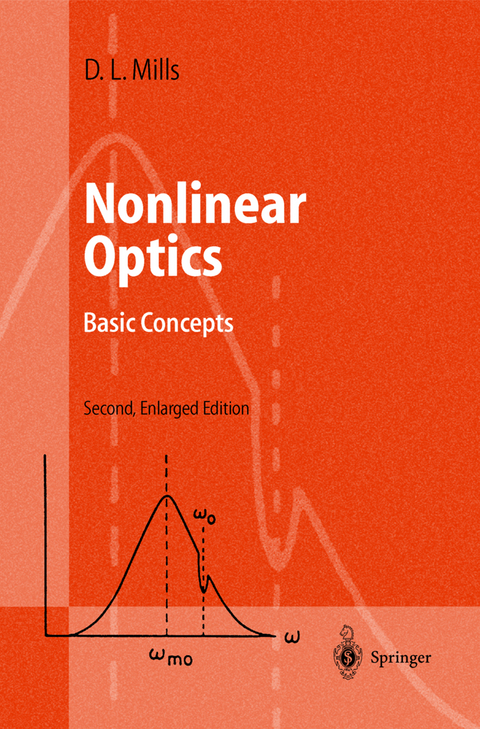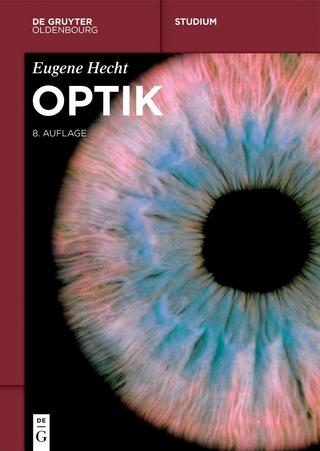
Nonlinear Optics
Springer Berlin (Verlag)
978-3-540-64182-7 (ISBN)
Studenten höherer Semester und Wissenschaftler, die mit diesem Gebiet vertraut werden wollen, finden in diesem Buch eine ideale Einführung in die Nichtlineare Optik, ein Thema von wachsender Bedeutung sowohl für Physiker als auch für Ingenieure. Unter den vielen Themen, die von besonderem aktuellen Interesse sind, findet man die Wellenausbreitung in optischen Fasern und Chaos.
Since the book was first published in 1991, the field of surface nonlinear optics has grown substantially to the point where an exposition of the principles of this field will prove useful to many. Thus, in this second edition, Chapter 8 addresses this area. Also, optical probes of magnetism of very thin films and multilayers are now widely used, and magneto-optic devices of increasing sophistication have appeared. Chapter 9 is thus devoted to magneto-optics, and associated nonlinear phenomena. The earlier chapter on "Chaos" appears as Chapter 10. The philosophy which underlies the first edition was also employed in the writing of the two new chapters. Irvine, CA D.L.Mills March 1998 Preface to the First Edition One intriguing aspect of physics is its dynamic and rapidly evolving nature; exciting new fields can become moribund within relatively few years, only to revive and grow again in a dramatic and explosive manner in response to new developments.
1. Introductory Remarks.- Problems.- 2. Linear Dielectric Response of Matter.- 2.1 Frequency Dependence of the Dielectric Tensor.- 2.2 Wave Vector Dependence of the Dielectric Tensor.- 2.3 Electromagnetic Waves in Anisotropic Dielectrics.- Problems.- 3. Nonlinear Dielectric Response of Matter.- 3.1 Frequency Variation of the Nonlinear Susceptibilities.- 3.2 Wave Vector Dependence of the Nonlinear Susceptibilities.- 3.3 Remarks on the Order of Magnitude of the Nonlinear Susceptibilities.- Problems.- 4. Basic Principles of Nonlinear Wave Interactions: Second Harmonic Generation and Four Wave Mixing.- 4.1 Perturbation Theoretic Analysis of Second-Harmonic Generation.- 4.2 Methods of Achieving the Phase Matching Condition.- 4.3 Evolution of the Second-Harmonic Wave under Phase Matched Conditions.- 4.4 Other Examples of Nonlinear Wave Interactions.- Problems.- 5. Inelastic Scattering of Light from Matter: Stimulated Raman and Brillouin Scattering.- 5.1 Quantum Theory of Raman Scattering.- 5.2 Stimulated Raman Effect.- 5.3 Contribution to Four Wave Mixing from the Raman Nonlinearity.- 5.4 Brillouin Scattering of Light.- Problems.- 6. Interaction of Atoms with Nearly Resonant Fields: Self-Induced Transparency.- 6.1 Description of the Wave Function under Near Resonant Conditions.- 6.2 Bloch Equations: Power Broadening and Saturation Effects in Absorption Spectra.- 6.3 Self-Induced Transparency.- 6.4 Area Theorem.- 6.5 Sine-Gordon Equation.- Problems.- 7. Self-Interaction Effects in One-Dimensional Wave Propagation: Solitons in Optical Fibers and in Periodic Structures.- 7.1 Normal Modes of Optical Fibers.- 7.2 Nonlinear Schrödinger Equation.- 7.3 Linear Theory of Pulse Propagation in a Dispersive Medium: Application to Optical Fibers.- 7.4 Solitons and the NonlinearSchrödinger Equation.- 7.5 Gap Solitons in Nonlinear Periodic Structures.- Problems.- 8. Nonlinear Optical Interactions at Surfaces and Interfaces.- 8.1 Second-Harmonic Generation from Surfaces; General Discussion.- 8.2 Nonlinear Optical Interactions at Surfaces and Interfaces; Examples.- 8.3 Resonant Enhancement of Electromagnetic Fields Near Surfaces and Interfaces and Their Role in Surface Nonlinear Optics.- 8.4 Experimental Studies of Surface Enhanced Nonlinear Optical Interactions.- Problems.- 9. Optical Interactions in Magnetic Materials.- 9.1 Introductory Remarks.- 9.2 Electromagnetic Wave Propagation in Ferromagnetic Materials; Faraday Rotation and the Cotton-Mouton Effect.- 9.3 Second-Harmonic Generation from Magnetic Materials; Surface Effects.- 9.4 Dynamic Response of the Magnetization and the Origin of Nonlinear Magnetooptic Interactions.- 9.5 Nonlinear Interaction of Light with Spin Waves in Ferromagnets.- Problems.- 10. Chaos.- 10.1 Duffing Oscillator: Transition to Chaos.- 10.2 Routes to Chaos.- 10.3 Experimental Observations of Chaos in Optical Systems.- Problems.- Appendix A: Structure of the Wave Vector and Frequency Dependent Dielectric Tensor.- Appendix B: Aspects of the Sine-Gordon Equation.- Appendix C: Structure of the Electromagnetic Green's Functions.- References.
"Fundamental principles and experimental results make this a very complete and accessible introduction. Used either as the basic of an MSc-level course or as a reader, this book will be invaluable as an introduction to the field for beginning graduates in physics or engineering. It will also provide an excellent overview and reference work for researchers already active in the field." (Physicalia 35/1999) Anyone planning to use this book as a guide for a second- year graduate course in nonlinear optics would have to include a great deal of outside reading, or supplement it with one of the more established texts in the field (for example, Yarivs). As a note on structure, I would have appreciated a much more detailed index, and especially an author index with cross references to the subject index. Given the audience Mills is attempting to address, these additions would add greatly to its usefulness. I recommend this book to any first-year graduate student who may wish to learn about the opportunities of this exciting field. But to really learn what is going on, or what is involved in the subject, the student will need to be guided by a book that goes into greater details. RICHARD R. FREEMAN University of Californio, Dauis Physics Today, 9, 1999 This will be an extremely useful text for those wishing to enter the field of non-linear optics, provided that they already are well-versed in electromagnetic . theory and the basic tools of mathematical physics. ln short this is a book for practised theoretical (or; at least, theoretically-minded) physicists who wish to gain familiarity with the subject for interest or for research. It will also be useful as a reference for practi- cal physicists in the field, provided that it is sup- plemented with texts which provide more data from the real world. The book contains well-considered problems at the end of each chapter (but no solutions), three useful appendices, and a comprehensive reference list. A.J. Rogers King's College London, School of Physical Sciences, (Optics and Laser Technology, 31, 1999 "The text develops the basic principles that underlie nonlinear optical phenomena in matter, in an approach orientated to the general reader or student with a background in classical electromagnetic theory. ...The text is aimed at the student or researcher who is not a specialist in optics, and who wishes to acquire an introduction to the principal concepts as a precursor to the consultation of the specialized literature." P. Fleischmann, Zeitschrift für Licht und Elektronenoptik, 2000, 111, 11
"Fundamental principles and experimental results make this a very complete and accessible introduction. Used either as the basic of an MSc-level course or as a reader, this book will be invaluable as an introduction to the field for beginning graduates in physics or engineering. It will also provide an excellent overview and reference work for researchers already active in the field." (Physicalia 35/1999) Anyone planning to use this book as a guide for a second- year graduate course in nonlinear optics would have to include a great deal of outside reading, or supplement it with one of the more established texts in the field (for example, Yarivs). As a note on structure, I would have appreciated a much more detailed index, and especially an author index with cross references to the subject index. Given the audience Mills is attempting to address, these additions would add greatly to its usefulness. I recommend this book to any first-year graduate student who may wish to learn about the opportunities of this exciting field. But to really learn what is going on, or what is involved in the subject, the student will need to be guided by a book that goes into greater details. RICHARD R. FREEMAN University of Californio, Dauis Physics Today, 9, 1999 This will be an extremely useful text for those wishing to enter the field of non-linear optics, provided that they already are well-versed in electromagnetic . theory and the basic tools of mathematical physics. ln short this is a book for practised theoretical (or; at least, theoretically-minded) physicists who wish to gain familiarity with the subject for interest or for research. It will also be useful as a reference for practi- cal physicists in the field, provided that it is sup- plemented with texts which provide more data from the real world. The book contains well-considered problems at the end of each chapter (but no solutions), three useful appendices, and a comprehensive reference list. A.J. Rogers King's College London, School of Physical Sciences, (Optics and Laser Technology, 31, 1999 "The text develops the basic principles that underlie nonlinear optical phenomena in matter, in an approach orientated to the general reader or student with a background in classical electromagnetic theory. ...The text is aimed at the student or researcher who is not a specialist in optics, and who wishes to acquire an introduction to the principal concepts as a precursor to the consultation of the specialized literature." P. Fleischmann, Zeitschrift für Licht und Elektronenoptik, 2000, 111, 11
| Erscheint lt. Verlag | 30.6.1998 |
|---|---|
| Zusatzinfo | XI, 263 p. 2 illus. |
| Verlagsort | Berlin |
| Sprache | englisch |
| Maße | 155 x 235 mm |
| Gewicht | 424 g |
| Themenwelt | Naturwissenschaften ► Physik / Astronomie ► Optik |
| Naturwissenschaften ► Physik / Astronomie ► Quantenphysik | |
| Technik ► Elektrotechnik / Energietechnik | |
| Schlagworte | Absorption • Chaos • Faraday rotation • Nonlinear Optics • Optics • Optik • Transparency |
| ISBN-10 | 3-540-64182-3 / 3540641823 |
| ISBN-13 | 978-3-540-64182-7 / 9783540641827 |
| Zustand | Neuware |
| Haben Sie eine Frage zum Produkt? |
aus dem Bereich


